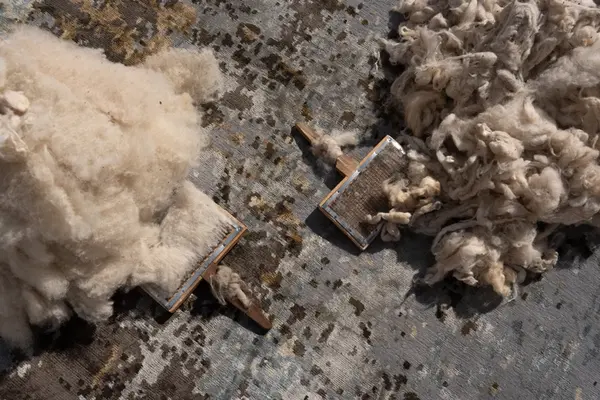Looking for eco-friendly, handmade rugs that blend aesthetics with environmental responsibility? You’re in the right place. This practical guide explores the top sustainable materials used in handmade rugs so you can make an informed, confident purchase.
As sustainability becomes more than just a trend and turns into a responsibility, choosing the right rug material matters—especially when shopping for wholesale rugs or outfitting your home with handmade decor that lasts.
1. Wool: The Timeless Eco-Friendly Staple
Wool is one of the most sustainable and durable materials used in handmade rugs. Its natural resilience and ability to be sheared without harming animals make it an excellent renewable resource. If maintained properly, wool rugs can last for decades, reducing the need for frequent replacements.
At NP Rugs, we use ethically sourced wool, ensuring animal welfare and environmental care go hand in hand. Wool is naturally flame-resistant, stain-resistant, and biodegradable—ideal for those prioritizing performance and the planet.
Learn how to maintain your wool rugs to extend their lifespan and beauty.
2. Jute: The Rising Star of Natural Fibers
Jute rugs have gained popularity due to their rustic look and low environmental impact. Jute plants grow quickly without the need for pesticides, and the fibers are fully biodegradable, making them an excellent choice for sustainable rugs.
Jute rugs are best suited for low-traffic areas like bedrooms or reading nooks. They offer great texture and are often paired with modern, bohemian, or coastal interiors. Interested in how jute performs in real homes? Read our guide on Jute Rugs: Pros, Cons, and Common Questions.
Also explore our guide to decorating with jute rugs.
3. Hemp: Strong, Stylish, and Low Impact
Hemp rugs combine eco-friendliness with industrial-grade strength. Hemp requires minimal water and grows rapidly, making it one of the most sustainable crops available. These rugs are highly durable, ideal for high-traffic areas such as hallways or commercial spaces.
Hemp also holds dye well and offers a textured, earthy feel that complements natural wood floors and minimalist designs. Many of our clients who invest in wholesale rugs prefer hemp for retail spaces and vacation homes due to its resilience and sustainability.
Hemp is just one of the ways NP Rugs prioritizes sustainability—see how we contribute to eco-conscious living.
4. Cotton: Affordable, Renewable, and Versatile
Cotton rugs provide a lightweight, affordable, and renewable option for eco-conscious buyers. They are soft, washable, and available in a wide range of colors and patterns, perfect for homes with kids or pets.
Organic cotton, in particular, uses less water and avoids harmful chemicals, making it a top pick for those aiming to reduce their carbon footprint. Cotton blends are often used in hand-tufted rugs, which provide softness without sacrificing sustainability.
Explore the difference between hand-knotted and hand-tufted rugs to find what fits your needs.
5. Bamboo Silk: The Eco-Luxury Choice
Bamboo silk, a fiber derived from bamboo pulp, is gaining traction for its luxurious sheen and low-impact cultivation. Bamboo grows extremely fast without pesticides or fertilizers, making it a renewable and earth-friendly option.
Rugs made from bamboo silk often mimic the shine of traditional silk rugs but are far more sustainable. They work beautifully in bedrooms and formal living areas, adding a soft luster underfoot.
Learn more about choosing the right rug for luxury buyers.
Why Sustainable Materials Matter in Wholesale Rugs
Sustainability isn’t just a buzzword. For businesses and designers sourcing wholesale rugs, choosing rugs made with eco-friendly materials supports long-term environmental goals and meets the demands of eco-conscious consumers.
At NP Rugs, we’ve been producing handmade rugs since 1991, combining traditional craftsmanship with ethical production practices. Whether you’re decorating a home or sourcing rugs in bulk, our sustainable materials guarantee beauty, function, and responsibility.
Learn more in our wholesale guide.
Tips for Choosing the Right Sustainable Rug
Start by thinking about room use and traffic levels. Wool and hemp are perfect for busy areas, while jute and bamboo silk work well in relaxed spaces. Consider rug sizes and layout with our size guide.
Don’t forget to think about rug color and home aesthetics. Natural fibers tend to have earthy tones, which blend well with neutral and nature-inspired interiors.
NP Rugs: Your Trusted Partner in Handmade Sustainable Rugs
NP Rugs has been crafting high-quality handmade rugs in Kathmandu, Nepal since 1991. Our commitment to ethical production, natural materials, and global distribution makes us a preferred choice for interior designers, retailers, and bulk buyers across the US, UK, Canada, and beyond.
We are proud to support the growing demand for handmade and sustainable rugs while offering complete customization for commercial or wholesale needs. If you’re looking to stock your store or decorate multiple spaces, visit our Wholesale Rugs page to explore the possibilities.
Need more insights on the materials and market trends? Don’t miss our rug material guide for wholesale buyers and wholesale trends for seasonal buying.
Final Thoughts
Choosing sustainable rug materials doesn’t mean sacrificing style or durability. From wool and jute to cotton and bamboo silk, every fiber offers something unique—and each one plays a role in creating a greener future.
Whether you’re a homeowner or a wholesale rug buyer, the material you choose matters. Explore our full rug collection or dive deeper with these related resources:
Want help picking the right rug material for your project? Contact us or visit our Wholesale Rugs section to speak with our team of experts.

